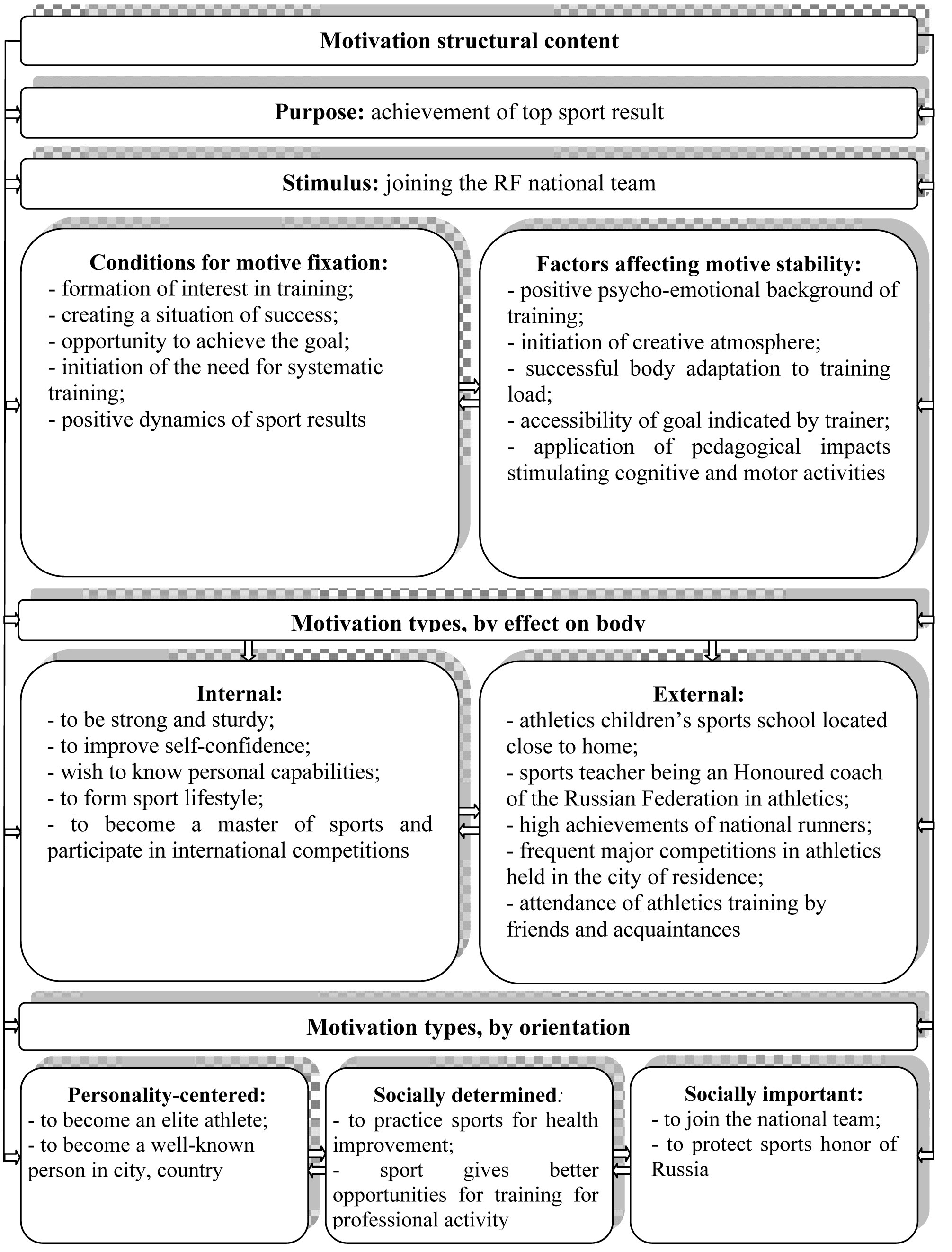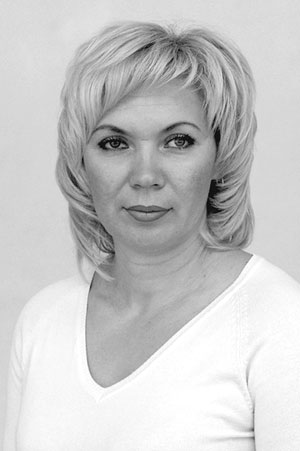Enhancement of Motivational Sphere as a Factor of Sports Skills of Female Sprinters
Фотографии:
ˑ:
E.A. Anisimova, associate professor, Ph.D.
L.D. Nazarenko, professor, Dr.Hab.
Ulyanovsk State Pedagogical University, Ulyanovsk
Key words: running, short distances, motivation, management, educational experiment, methodology.
Relevance. Speed work is specific for a sprinter, associated with an increase in aerobic performance. Sprinter's speed of movement is largely determined by the morpho-functional state of the musculoskeletal system [5, 9, 10]. Training process differs in its content by using similar in structure running exercises that causes the formation of relatively uniform dynamic stereotypes of neural processes underlying running. This contributes to higher requirements for the formation of the sprinters' motivational sphere and increase of the efficiency of control of motor activity.
The purpose of the study was theoretical and methodological substantiation of the role of motivation as a major component of sprinters' sports training.
Motivation due to the need for physical, intellectual, spiritual and moral development, determines the need to make all life interests, abilities and inclinations serve to achieve the long-term goal, form sports lifestyle. It largely determines the runner's level of physical working capacity and his desire to learn the rules of growth sports skills, conditions of improvement of fitness indicators [3, 9].
The leading motive and purpose of sports training, according to athlete's abilities and capacities, help to efficiently manage the motor activity via the feedback mechanism that ensures processing of relevant information about qualitative changes in the functional system, raise of the level of motor-coordination skills, formation of individual technique of running steps [1, 4, 5, 10].
The sensory systems provide the perception of information which is particularly important in competitive activity for the estimation of a contest situation, opponents’ actions and regulation of muscle efforts. The information coming from muscle proprioceptors, tendons and ligaments contains data on articular angles, mode of foot posing on a support, take-off force and speed, accuracy of spatiotemporal and spatio-force parameters of movements and efficiency of specific running exercises [6, 7, 8].
Materials and methods. With the aim to examine the efficiency of methodology of motivation sphere monitoring, an educational experiment was carried out; twenty three 18-22 year old female runners qualified as 1st class, candidate for masters and masters of sports were involved. The control group (CG) and the experimental group (EG) consisted of 11 and 12 persons, respectively. Training in the CG was fulfilled using conventional methods according to the program for sport training of runners, approved by the Russian Athletics Federation. The developed teachnique of improvement of the efficiency of motivation sphere monitoring was used when training the EG.
Results and discussion. The motivation structure (Fig.) is formed to a great extent by a stimulus as an impulse to intense and conscious training activity that provides achievement of one’s goal. For example, inclusion of a young sprinter into the national team after her success at preliminary qualification is a powerful stimulus for improvement of her working capacity and reaching the appropriate fitness level [3].
A test was made prior to the educational experiment to reveal initial physical fitness level; the test complex contained the following control exercises: 30 and 60 meter run (s) from standing start; 1000 meter run (min), standing long jump (cm), triple jump (cm), 3 kg shot put (m). An analysis of the test results revealed no significant differences in fitness levels of sprinters of the CG and the EG (р>0.05).
The initial level of special running fitness was also determined using the following tests: 100, 150, 200 and 300 meter run (s) from standing start. The processing of the research results also did not reveal significant differences in the special running fitness level between the sprinters of the CG and the EG.
The following issues were detected among the athletes of the EG during the educational experiment:
- whether they had some personal goals during training, or they just pursued the purposes indicated by the trainer;

Fig. Structural content of motivation
- how female sprinters strived for the achievement of goals indicated by the trainer (if the goals were considered to be real, too high or too low; whether additional efforts were applied to achieve these goals, such as more thorough warm-up, increase of the running exercise reps, using more time for muscle force development at the expense of leisure time, practicing self-initiated runs for better general endurance, etc.). The ability of female runners for an objective appraisal of their capabilities was estimated as well. In this regard, every athlete was asked how she estimated her readiness for coming competitive activity at the moment:
- improved results as compared to last competitions and how big was the improvement;
- running speed at the distances remained approximately the same;
- how the results lowered due to some reasons.
The answers were compared with trainer’s ones, and if they differed, it was discussed how to improve specific results by revealing additional reserves (paying more attention to timely redistribution of muscle efforts at the distance, earlier start of the final spurt, inclusion of extra exercises for leg muscle strength development into training, etc.).
Besides, it was clarified how well female sprinters understand the dependence of result on their abilities, and what reserves to use for result improvement. In this regard, individual additional training were proposed to them, such as running exercises under complicated conditions: acceleration uphill, on the sand, on shallow snow and so on.
In our opinion, it is important for every athlete to realize the level of her pretensions in the sport, contentment with her results, organization and applied system of training. One of interesting questions, in our opinion, is the relations between motives and aims of sport activity: how motives, and correspondingly purposes outlined at competitions, change with the growth of fitness level and sport achievements.
The results of our research show that the motive of sports activity was getting more complex with the improvement of sport skills. Thus, the initial motive (to become a master of sports) was close to fulfillment, it was complemented with another one: to enter Russian national team and to occupy one of the leading positions in it. The motive of participation in international competitions developed into the particular purpose – to become a prize winner at these competitions, and so on.
As personality-centered motives transformed into socially significant ones, the purposes also became more complex, that was evidently caused by the revelation of unused latent opportunities and abilities to improve working capacity, and by the search for ways for improvement of the technique of sprinter training.
The indices of both general physical and specific running fitness were retested after the educational experiment was completed, in order to reveal the dynamics of these parameters. An analysis of the results of the educational experiment showed that these results improved in both groups, the CG and the EG, and this improvement was significantly higher in the EG. Initially the results in 30 meter run from standing start were 4,40±0,29 s and 4,39±0,31 s, and by the end of the educational experiment they increased by 1,17% and 3,21% (p>0,05) for the CG and the EG, respectively. The initial results in 60 meter run from standing start were 7,84±0,45 s and 7,85±0,55 s, and by the end of the educational experiment they improved by 1,19% and 3,12% (p>0,05) for the CG and the EG, respectively. A similar trend of increase of the parameters of general physical fitness was observed in other tests.
The parameters of special basic fitness also improved in both of the groups upon the educational experiment. While the initial results in 100 meter run from standing start were 13,30±0,79 s and 13,28±0,66 s, by the end of the educational experiment they improved by 1,78 % and 3,81% (p>0,05) in the CG and the EG, respectively. In the control group the initial result in 150 meter run from standing start was 20,80±1,24 s, and it increased by 3,14% (p>0,05). The initial results in 200 meter run from standing start were 26,17±0,15 s and 26,15±0,17 s, by the end of the educational experiment they increased by 1,67% and 2,94% (p>0,05) in the CG and the EG, respectively. A similar trend of higher increment of test results in the EG was observed for other tests as well.
Conclusion. Thus, according to the results of the educational experiment, various factors affecting the growth of sports skills should be considered in sports training of sprinters; underestimation of a number of psychological-educational, social and other factors greatly reduces the effectiveness of competitive activity. Motivation is one of the key components in sport training; effective management of the motivational sphere must be considered as one of the understudied promising ways to improve the training process.
The results of the educational experiment proved the feasibility of using the methodology of enhancement of control of the motivational sphere of qualified female sprinters, which positively affected the growth of competitive results.
References
- Anisimova E.A. Technological support of the sports training process of sprinters / E.A. Anisimova // Pedagogiko-psikhologicheskue i mediko-biologicheskie problemy fizicheskoy kul'tury i sporta. – 2013. – № 3 (28). – P. 24-27. (In Russian)
- Vidrin V.M. Physical culture as a type of personality and social culture / V.M. Vidrin. – Omsk: pub. h-se of SibSAHA., 2003. – 141 P. (In Russian)
- Lubysheva L.I. Sociology of physical culture and sport / L.I. Lubysheva. – Moscow: Academia, 2001. – 240 P. (In Russian)
- Nazarenko, L.D. Theoretical proof and methodology of development of rhythmicity / L.D. Nazarenko, J.A Ignatieva // Fizicheskaya kultura: vospitanie, obrazovanie, trenirovka, 2000. – № 1. – P. 45-50. (In Russian)
- Nazarenko, L.D. Means and methods of development of motor coordination / L.D. Nazarenko. – Moscow: Teoriya i praktika fizicheskoy kultury, 2003. – 258 P., illust. (In Russian)
- Pavlov, G.K. Assessment of neuromuscular apparatus and its use in control of the process of speed-strength training of athletes / I.T. Lysakovsky, A.E. Axelrod, G.K. Pavlov // Teoriya i praktika fizicheskoy kultury. – Moscow, 2005. – № 10. – P. 25-26; 39-42. (In Russian)
- Piloyan, R.A. Improving efficiency of physical education / R.A. Piloyan // Teoriya i praktika fizicheskoy kultury. – 2005. – № 12. – P. 48-51. (In Russian)
- P'yanzin, A.I. Proportionality of repulsion parameters in the formation of model characteristics of fitness of qualified sprinters / A.I. P'yanzin, E.V. Solodenov // Teoriya i praktika fizicheskoy kultury. – 2008. – № 6. – P. 46-50. (In Russian)
- Tyupa, V.V. Biomechanical grounds of the walking and jogging technique / V.V. Tyupa, V.V. Arakelyan, Yu.N. Primakov. – Moscow: Olimpiya, 2009. – 64 P. (In Russian)
- Ward-Smith, A.J., Radford P.F. Investigation of kinetics of anaerobic metabolism by analysis of the performance of elite sprinters // J. Biomech. – 2000. – Aug. – 33 (8). – P. 997-1004. (In Russian)
Corresponding author: elena_funina@mail.ru




 Журнал "THEORY AND PRACTICE
Журнал "THEORY AND PRACTICE